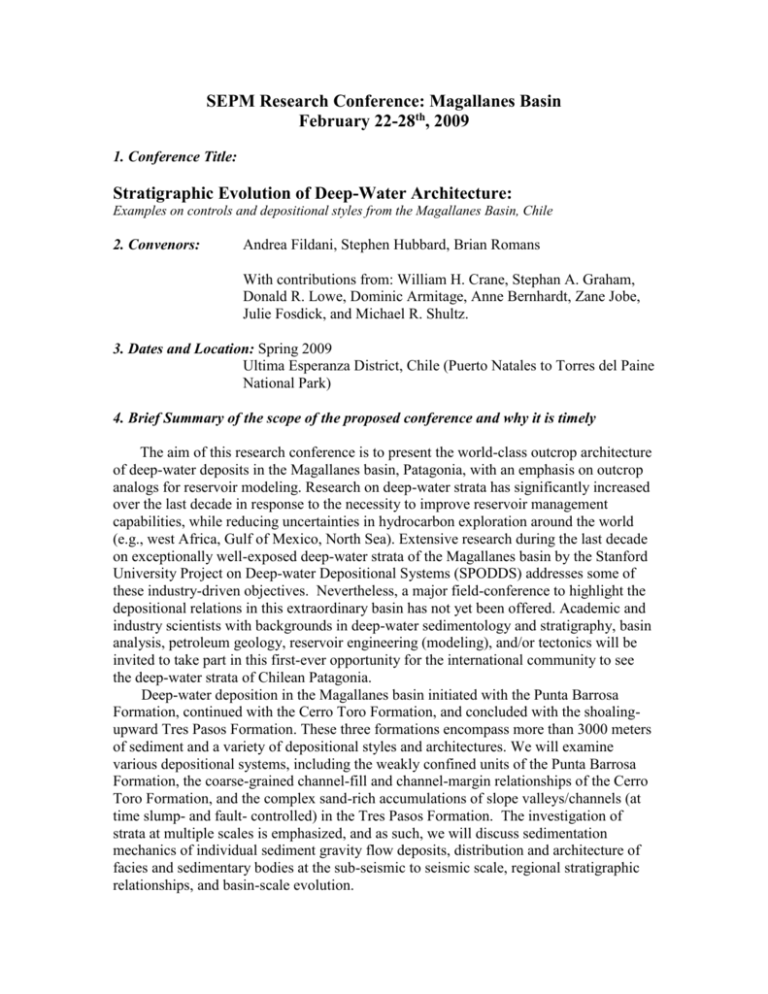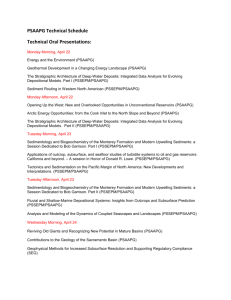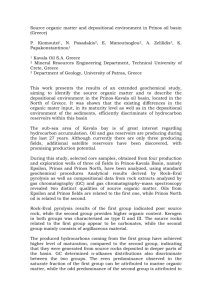SEPM Research Conference: Magallanes Basin
advertisement

SEPM Research Conference: Magallanes Basin February 22-28th, 2009 1. Conference Title: Stratigraphic Evolution of Deep-Water Architecture: Examples on controls and depositional styles from the Magallanes Basin, Chile 2. Convenors: Andrea Fildani, Stephen Hubbard, Brian Romans With contributions from: William H. Crane, Stephan A. Graham, Donald R. Lowe, Dominic Armitage, Anne Bernhardt, Zane Jobe, Julie Fosdick, and Michael R. Shultz. 3. Dates and Location: Spring 2009 Ultima Esperanza District, Chile (Puerto Natales to Torres del Paine National Park) 4. Brief Summary of the scope of the proposed conference and why it is timely The aim of this research conference is to present the world-class outcrop architecture of deep-water deposits in the Magallanes basin, Patagonia, with an emphasis on outcrop analogs for reservoir modeling. Research on deep-water strata has significantly increased over the last decade in response to the necessity to improve reservoir management capabilities, while reducing uncertainties in hydrocarbon exploration around the world (e.g., west Africa, Gulf of Mexico, North Sea). Extensive research during the last decade on exceptionally well-exposed deep-water strata of the Magallanes basin by the Stanford University Project on Deep-water Depositional Systems (SPODDS) addresses some of these industry-driven objectives. Nevertheless, a major field-conference to highlight the depositional relations in this extraordinary basin has not yet been offered. Academic and industry scientists with backgrounds in deep-water sedimentology and stratigraphy, basin analysis, petroleum geology, reservoir engineering (modeling), and/or tectonics will be invited to take part in this first-ever opportunity for the international community to see the deep-water strata of Chilean Patagonia. Deep-water deposition in the Magallanes basin initiated with the Punta Barrosa Formation, continued with the Cerro Toro Formation, and concluded with the shoalingupward Tres Pasos Formation. These three formations encompass more than 3000 meters of sediment and a variety of depositional styles and architectures. We will examine various depositional systems, including the weakly confined units of the Punta Barrosa Formation, the coarse-grained channel-fill and channel-margin relationships of the Cerro Toro Formation, and the complex sand-rich accumulations of slope valleys/channels (at time slump- and fault- controlled) in the Tres Pasos Formation. The investigation of strata at multiple scales is emphasized, and as such, we will discuss sedimentation mechanics of individual sediment gravity flow deposits, distribution and architecture of facies and sedimentary bodies at the sub-seismic to seismic scale, regional stratigraphic relationships, and basin-scale evolution. We propose that this meeting will be focused on four themes centered around formations to be examined over 5 days in the field (including workshops and presentation sessions). Outcrops visited will be complemented by discussion of analogous outcrops and/or subsurface deposits from around the world, based around presentations given by field trip participants. This approach is aimed at generating constructive debates and honing concepts for the various topics. The themes, as discussed in section 5 below, include a session on the Magallanes basin evolution and development of deep-water depositional phases, and the distinctive depositional architecture of coarse-grained units in the three formations (Punta Barrosa, Cerro Toro, and Tres Pasos). 5. Tentative Program Outline 5.1 Introduction Various aspects of the Magallanes foreland basin are relevant to the advancement of sedimentological concepts and models. Gravity flow processes (from bed-scale observations) through to the tectonostratigraphic evolution of the basin represent endmember scales of investigation for strata of the basin. Historically, the study of uplifted foreland basin fill has been particularly influential in the development of classical deepwater facies models, from the bed-scale (e.g., work of Kuenen, Bouma, etc.), to the depositional system and basin scale (e.g., work of Mutti, Ricchi Lucchi, etc.). Of particular interest in this field workshop, is the examination of deep-water deposits in outcrop to (1) understand sedimentary processes in the deep-water realm, (2) understand sediment distribution for the utility of hydrocarbon exploration in other deep-water provinces, (3) provide analogs to hydrocarbon reservoirs, and (4) use of stratigraphic packaging as a predictive tool in deep-water exploration. Three-dimensional seismic data has become an invaluable tool in the exploration of hydrocarbons. An inherent limitation to the data in many instances, however, is the difficulty in resolving deposits at the scale of reservoirs. Another major limitation of projects based solely on seismic data (e.g., exploration activities) is the lack of rock information. Large and well-exposed outcrops allow us to focus on both the high-resolution geometries and facies variability from the reservoir- to seismic-scale. The value of outcrop studies is that they provide an opportunity to link observed patterns directly to process. In other instances, outcrop patterns are used more directly as a basis for modeling and fluid flow simulation of analogous subsurface reservoirs. 5.2. THEME 1. Tectonic history and development of the Magallanes basin The Magallanes foreland basin is an elongate, north-south oriented trough located adjacent to the Patagonian Andes, the crustal loading of which was responsible for its genesis. The basin has an oceanic back-arc heritage (Rocas Verde basin) that was first initiated in the region during the latest Jurassic to Early Cretaceous by rifting associated with the break-up of Gondwana. Initiation of the Andean Orogeny and associated foldthrust belt development spawned the transition from a back-arc to foreland basin setting, a transition that was recorded by deposition of turbiditic strata of the Punta Barrosa Formation. Deep-water conditions persisted in the Magallanes basin for a period of ~20 myr, through deposition of the Cerro Toro and Tres Pasos formations. Upward shallowing during the Late Cretaceous and Tertiary is recorded in deposits of the Dorotea Formation. Foreland strata were incorporated in the thrust-belt during the Cenozoic, and the excellent outcrop exposures we see today reflect the combination of the geometry of open folds and late Cenozoic glaciation. In this theme we will consider: - The context for sedimentation in the Magallanes foreland - The stratigraphic architecture of the basin and it’s evolution through time - Structural elements that effected both sedimentation, and eventually outcrop exposure quality - Outcrop locations: various roadside stops along a north-south transect of the Ultima Esperanza District 5.3. THEME 2. Deep-water deposition in a weakly confined setting: Examples from the Punta Barrosa Formation (Kpb) Weakly to fully unconfined deposits (sheets) are becoming a key target in deep-water exploration (e.g., GOM). The Punta Barrosa Formation was deposited during the first deepwater, coarse-clastic depositional stage of the Magallanes foreland. Because of its proximity to the Andean belt, the Punta Barrosa Formation is pervasively thrusted and folded. Nevertheless, outcrops of the upper Punta Barrosa to the east of the fold-thrust belt are not as extensively affected by tectonism and display better lateral continuity and architecture. The ~1000 meter (~3300 ft) thick Punta Barrosa Formation consists of interbedded packets of sandstone and mudstone. The bedding attitude and depositional style is characterized by layered and sometimes amalgamated beds. In this theme we will consider: - Character of the Kpb as a response to basin evolution (early foreland evolution) Architecture description and packaging styles (weakly confined architecture) Process sedimentology of slurry-flows deposits (sensu Lowe et al., 2003) Outcrop locations: New Highway Cut, Marina’s Cliff, Park Headquarters 5.4. THEME 3. Large-scale channel (channel levee complex) processes and architecture: Examples from the Cerro Toro Formation (Kct) Large channel and channel-levee complex deposits are widely associated with oil and gas reservoirs around the world. Conglomerate and sandstone of the Cerro Toro Formation crops out in a north-south belt for > 100 km, extending from the Chile-Argentina border in the north, to at least as far as Puerto Natales. Coarse-grained gravity flows were focused within a wide channel belt (southward flowing) that was present along the axis of the Magallanes basin foredeep. In this theme we will consider: - the relationship between channel and out-of-channel strata (genetically and nongenetically related units) - the internal architecture of channel fill and the sedimentary processes responsible for its deposition the change in channel architecture along the length of the depositional system (over > 70 km) the effects of confinement on the channel system imparted by basin architecture relationship of channel bodies with large-scale clastic intrusions and their potential effect on reservoir performance the tectonic significance of the introduction of gravelly material to the Magallanes basin channel-levees vs. incised-slope channels: criteria to recognize differences and key similarities outcrop locations: Silla Syncline, Sierra del Toro, Cerro Benitez 5.5. THEME 4. Sandy depositional elements associated with local topography on the basin slope: Examples from Tres Pasos Formation (Ktp) Oil and gas sequestered in sand bodies within mud-rich slope successions represents an important resource in numerous basins. Deposits of the Tres Pasos Formation record the transition from bathyal water depths in the underlying upper mud-rich portion of the Cerro Toro Formation to the deltaic and shallow-marine strata of the overlying Dorotea Formation. The Tres Pasos Formation offers seismic-scale (often three-dimensional) outcrops of units that were deposited on a progradational delta-slope system. The Tres Pasos Formation is dominated by mass transport complexes punctuated by sandstone-rich lenses of variable thickness (10-100 m) and extent (few tens of meters to > 1 km). This theme focuses on: - - - the variety of accommodation-space (sensu latu) generating mechanisms on the slope and their reflection in the rock record (e.g., slump-generated, growth-fault generated, etc.) the architecture and associated depositional processes of various sandstone bodies accumulated in local topographic lows on the slope (lobes, channels, scour-fills, etc.) the tectonic significance of the shift from deposition of gravels in the underlying Cerro Toro Formation to the Tres Pasos Formation Outcrop locations: Sierra Contreras, El Chingue Bluff, Laguna Figueroa 6. Tentative Schedule (outcrop visits in bold; presentation sessions in blue) DAY 1 Feb 22 (pm) - Meet at Rio Serrano Hotel, Torres del Paine - ice-breaker DAY 2 Feb 23 (am) - background/basin information and conference overview; presentation(s) on weakly confined sedimentation – context for Kpb (pm) - Punta Barrosa outcrops (Marina’s cliff; HQ; roadcut) DAY 3 Feb 24 (am) – Presentations on large-scale channels, processes, modeling, etc. (pm) - Silla Syncline #1 (half day to look at margin on south side of park highway, by big slurry flow) DAY 4 Feb 25 (am) – Presentations on levee processes and recognition in the field (pm) – Cerro Benitez overview with a focus on the top of the section (dunes and sandy turbidites) (evening) POSTER Session DAY 5 Feb 26 (am) – Presentations on sandstone sedimentation on the slope (pm) – Lower – Middle – Upper Picana outcrop visit DINNER at the Tres Pasos Hotel DAY 6 Feb 27 - (am) - Figueroa outcrop visits (pm) – presentations on utility of work to subsurface study; informal conference get-together party and ideas exchange DAY 7 Feb 28 – (am) – leave hotel






